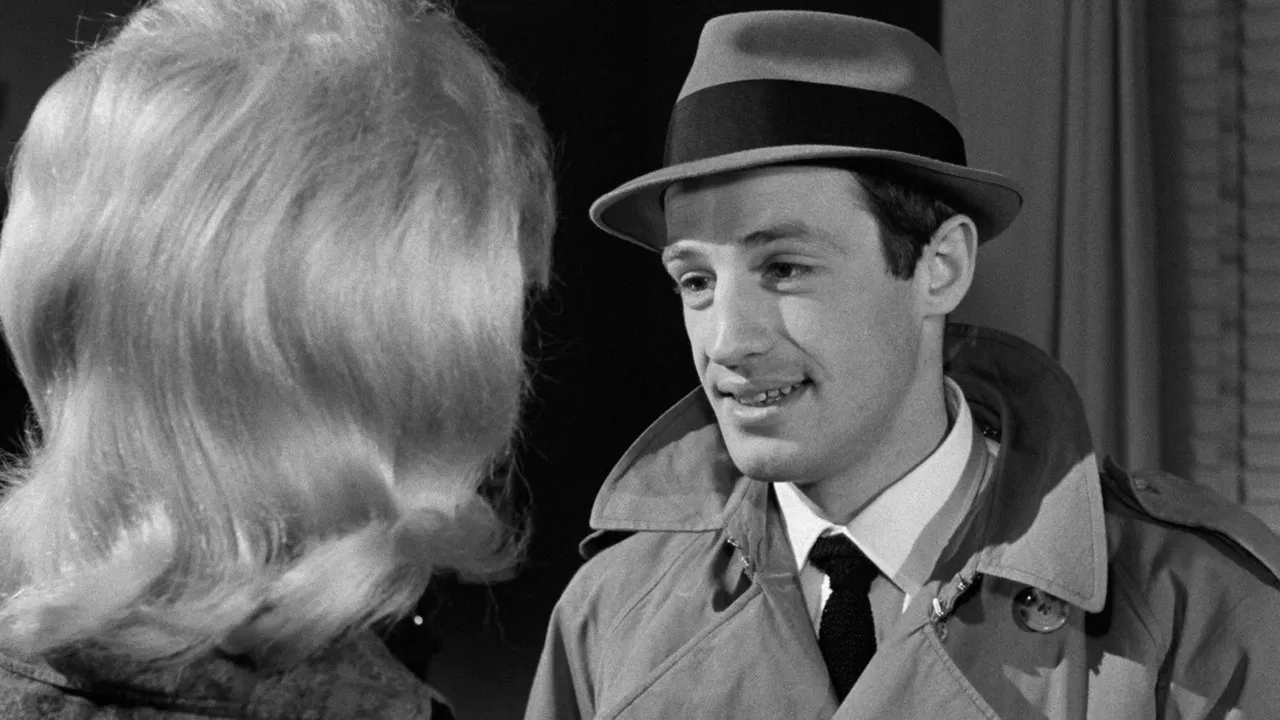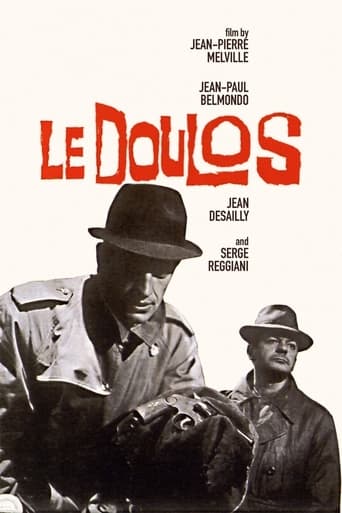

Along a long walkway, emerging from the dark, the shadowy silhouette of Serge Reggiani as Maurice Fogel, a taciturn and solitary figure walking beneath a bridge in a long track shot paralleled with the opening credits. His footsteps resonate as the passing of time's ticking. At one point, the camera 'loses' him to follow the long shots of horizontal linearity tracing a destiny foreshadowed by the opening existentialist sentence : 'One must choose to die or to lie'.Maurice enters an isolated sinister house and sees himself in the mirror. He meets Gilbert in a dark little room upstairs and their discussion economically delivers precious information on Maurice's background. He's an ex-con, who lost his touch and a girlfriend named Arlette and is preparing a robbery. Gilbert is obviously an old friend, warning Maurice about one of his acquaintances : a man named Silien, he offers him food, advice, and even a gun what follows introduces us the duplicitous relationships prevailing in the underworld.There starts a mind-blowing masterpiece of deliberate confusion, as the fundamental element on which survival is based. This ability to lie is vital for le Doulos, literally, the man with the hat ('le Doul' in French slang), the cop informer, Silien, portrayed with the perfect mix of detached elegance and methodical professionalism, by a young Jean-Paul Belmondo. "In this business, you either die like a bum or full of lead" Silien highlights the ephemeral and futile nature of his profession, whose only exit is to get rich and leave. Silien's plans feature a big house in Province, a beautiful woman, and a nice retirement for his friend, Maurice.Friendship and loyalty are recurring themes in Melville's filmography, even in a world of thugs and murderers. Without principles, there would be basically no character to root for, and ultimately no tragedy. Both Silien and Maurice are crooked, but not morally corrupted. Maurice killed his friend Gilbert because he 'silenced' Arlette, and he could never have killed him if he hadn't turned his back. Melville was ahead of his time in his way to juxtapose ethical behavior with criminal acts. And if Silien's actions and involvement with the police inspire our suspicion, a long flash-back sequence debriefs us about Silien's true motives : Melville 'got us'."Le Doulos" contains all the classic Melvillian codes. The perfectionism of Silien and Maurice echo the iconic Samurai of Delon. The movie is so attention-demanding, several scenes need to be seen again like Maurice cleaning all the spots he touched before leaving Gilbert's house. The cops have this intelligence and refinement that create sumptuous interactions with the criminals. There's an extraordinary sequence where Silien discusses with Clain, the Police Chief, with a 360° panoramic view and no edit during exactly 8 minutes. The stunning black-and-white cinematography embodies the grim atmosphere. The first scene itself is an expressionist masterpiece in the way light reveals Maurice's duplicity with only half of his face visible, an ambiguity illustrated by the swinging lamp's dizzying effect.Melville's genius is in the way he manipulates us, our regards toward the characters' motives are altered all through the film, and no conclusion is to be taken for granted, a reminiscence of the Occupation years when anyone could be a resistant or a collaborator, a friend or a traitor. The script and the editing maintain a suspenseful uncertainty as we never see Silien and Maurice interact. And even our perceptions change, we all see Silien as a vicious individual in the beginning, but when he takes off his hat, he's a vulnerable kid, an innocence confirmed by his smiling expression when we walks in the last scene, mirroring the first one with a sad premonition, subtly hinted by an allusion to "The Asphalt Jungle"'s ending, the theme of failure was also particularly cherished by John Huston.John Huston, William Wyler, Robert Wise Melville, who took his name from the novelist Herman Melville, was a vivid admirer of the great American gangster films. "Le Doulos" is to Melville, what "Kill Bill" is for Tarantino, a tribute to a worshiped genre. It features fedora hats, trench coats, cocktail bars, glasses of scotch, unfaithful dames, guns, lies, betrayal, honor and redemption, an anachronistic universe when we consider the Paris of the 60's. There is something totally Americanized and 40's in Melville's Paris. I was even surprised by the cars, so unusually big for the Parisian setting. Ultimately, the only indications of the sixties are the hairdo and clothes of Maurice's girlfriend Therese.Which brings up a controversial issue : Melville's universe is a male one where women hardly play a significant part. I was shocked by the treatment of the beautiful Therese, before her informer nature is revealed. She's slapped, knocked out by Silien, tied up. He empties a bottle of whiskey on her face, humiliating her by messing up her face while he stays elegant. This brutal treatment followed by her fatal disproportional punishment, illustrates the gangster's cold-blooded nature, and the outsider status of women. Melville used women as foils for the virility of his characters, he didn't even cast female stars, as their acting seem awkwardly inferior to the men. Thérèse was played by an amateur, Melville's secretary, and she was a good an actress as the informer was a liar. Get the point? But despite all the precautions taken by Silien, he couldn't prevent Maurice from hiring someone to kill him, while he was still considered a rat. Silien's house gave the unfortunate clue that he wasn't going to end like a bum. The thrilling climax responds to the codes of Greek tragedy with the two men who can't escape from their nature. Silien looks at himself in the mirror with the figure of a man entrapped in his condition, and the only way to get out of it, and conquers back a poignant humanity, is to let the hat fall
... View MoreAn interesting film noir that has all the elements one would expect of the gems of the 40s and 50s made in Hollywood: trench coat, hat, and gun.Serge Reggiani is Maurice. Just released from prison, it is not long before he is set up by his supposed friend Silien (Jean-Paul Belmondo).The cops are looking for who shot one of their own and who shot a fence. There is a lot of double crossing going on among the thieves.The look and feel of the film is spectacular. The big cars, the scenes, the great music: it all works to make for an excellent noir experience.The ending really surprises in a way I did not expect. Well, if I expected it, it wouldn't be a surprise would it? Just when everything gets tied together, it all comes undone again.Damn, the music was perfect.
... View MoreTo dramatize gangsters because of some fictitious "code"...to romanticize them by dressing them in trench coats with the collars pulled up and Borsalinos on their heads...is not just naive, it's downright silly. One wonders what Melville, with Cagney and Raft in his system, would have done with some modern thugs like Vincent "Vinny Gorgeous" Basciano, Peter "Rabbit" Calabrese or Jake "Greasy Thumb" Guzik. These hefty slobs would look ludicrous in fedoras, and their "code" included back shooting each other. Melville's fascination with idealized and rigidly unreachable gangsters comes across almost as weird as Hitchcock's fascination with blond ice queens who can be humiliated. We're talking fetish, and if Melville and Hitchcock weren't such masterful movie makers they'd probably be discussed in psychology textbooks and not in articles by film historians. But Melville and Hitchcock are masterful directors, and even their failures are interesting. Melville's Le Doulos is by no means a failure. It's a story of betrayal and double crosses and then more double crosses, some real, and some by tough men who make wrong assumptions. There's a sizable body count among those who wear trench coats and Borsalinos. The movie has that gritty, depressing, shadowed look of great noirs. If you're into masterful craftsmanship, Le Doulos is hard to beat. Le Doulos tells us about Maurice Faugel (Serge Reggiani), a tired gangster just out of prison who knows someone informed on him. He kills the man, but did he get the right man? He plans a burglary, using his girl to check the place out and a friend, Silien (Jean-Paul Belmondo), to loan him the safe-cracking equipment. Bad luck again; the cops show up, one gets killed and Faugel gets a bullet in his shoulder. This time we think we know who the stoolie is. We'd be foolish to place a bet on it. Or would we? Now the story becomes as much about Silien as Faugel. Belmondo's Silien may be an oily charmer, but Belmondo gives him dangerous shock value as well as star charisma. His questioning of Therese, Faugel's girl friend, is startling I don't buy the theory that a storyline that appears confusing is probably a great director's way of either playing with the audience or having an approach that is just too subtle for most of us to grasp. My theory is that, more often than not, the director simply lost control of the material, or ran out of production and editing time, or possibly just got a little bored with the project. I have no idea which was the reason with Le Doulos, but the storyline, already intricate with double crosses, leaves a lot for last minute tidying up. Silien's recapitulation of events, shown in flashback, doesn't help much. I started to think I must be in an English drawing room listening to Hercule Poirot explain how it all happened. Except...did I miss something at the end? No, but you sure better have an excellent memory for characters seen once, almost instantly. When you see finally what the last twist is, it seemed to me to be a case of heavy-handed theatrical irony. The movie is a great technical experience to watch. It's a fine example of Melville's technical mastery of his craft and his fascination with film gangsters and the self-imagined world he places them in. The story? For me, not all that involving; it's the storytelling that's the pay off. Melville's reputation, in my view, rests firmly on Army of Shadows, Bob le Flambeur and, to a lesser extent, Le Cercle Rouge. The more he veered into gangster style at the expense of the story, the more he veered into the world of film dilettantes and of professors of film studies. You know, the kind who love long tracking shots. Melville deserves better than what some of his professional enthusiasts lavish on him.
... View MoreA top notch game of cat(s) and mice from Jean Pierre Melville focusing on the seediest of small-time crooks. Police informer Jean-Paul Belmondo, showing extraordinary gumption, rats out "frenemy" Serge Reggiani and then attempts to swipe some loot Reggiani himself had stolen from other crooks. It's all tightly wound with a ton of twists and turns. Belmondo is excellent as is Reggiani (though he seems a bit old to be playing such a role). Michel Piccoli appears briefly as crooked nightclub owner and Fabienne Dali is terrific as a two-timing party girl. Boasting great title design and a slick music score, LE DOULOS (or "hat" or "informer") is both stylized and realistic at the same time. It's one of Melville's best.
... View More